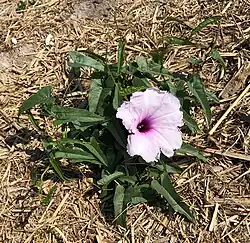Ipomoea calobra
| Ipomoea calobra | |
|---|---|

| |
| Scientific classification | |
| Kingdom: | Plantae |
| Clade: | Tracheophytes |
| Clade: | Angiosperms |
| Clade: | Eudicots |
| Clade: | Asterids |
| Order: | Solanales |
| Family: | Convolvulaceae |
| Genus: | Ipomoea |
| Species: | I. calobra
|
| Binomial name | |
| Ipomoea calobra | |
Ipomoea calobra, commonly known as weir vine, is an Australian native plant[2] found in northern Australia, largely Western Australia and Queensland.[3]
Description
It is a climber growing up to 6 m high, with purple-blue-pink trumpet flowers from January to June.[2]
Habitat
It occurs on undulating plains, dunes, and hardpans in red sandy and clayey soils, and pebbly loam,[2] and is often found twined up mulga and other acacias.[4]
Uses
The tubers of this species are edible, and were a highly favoured staple food source (bush tucker) for Indigenous Australians.[4] The mature tubers are broadly similar nutritionally to sweet potato (Ipomoea batatas), with higher concentrations of starch, potassium (K), copper (Cu) and zinc (Zn).[5]
Aboriginal names
In some parts of Australia, I. calobra is also known to Aboriginal people by the following names:[5]
- Murchison-Gascoyne area (WA): kulyu
- Tjupan Ngalia group (Leonora, WA): wutha/wather
References
- ^ "Ipomoea calobra". Australian Plant Census. Retrieved 16 February 2021.
- ^ a b c Grazyna Paczkowska (8 November 1996). "Ipomoea calobra W.Hill & F.Muell. Weir Vine". FloraBase. Western Australian Herbarium. Retrieved 14 December 2020.
- ^ "Occurrence records". The Australasian Virtual Herbarium (AVH). Atlas of Living Australia. Retrieved 14 December 2020.
- ^ a b Low, Tim (1991). Wild Food Plants of Australia. Angus & Robertson. p. 163. ISBN 0207169306.
- ^ a b Woodall, G.; Moule, M.; Eckersley, P.; Boxshall, B.; Puglisi, B. (2010). "New Root Vegetables for the Native Food Industry: Promising Selections from south Western Australia's tuberous flora (09/161)" (PDF). Rural Industries Research and Development Corporation. Retrieved 16 February 2021.